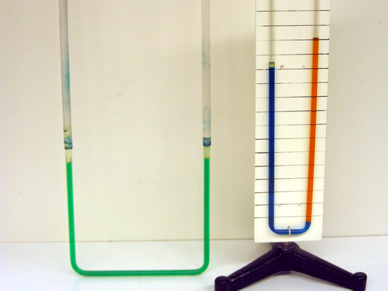Breadcrumb
2B35.30 - Manometers

Code Number: 2B35.30
Demo Title: Manometers
Condition: Excellent
Principle: Air Pressure
Area of Study: Heat & Fluids
Equipment: Manometers.
Procedure:
Fill the manometers with the desired liquid for comparison or observation. It is recommended that mercury not be used because of its environmental hazards.
References:
- Athanasios Gkourmpis, "Buildiing a Manometer for Gases and Liquids With a Smartphone and a Food Storage Container", TPT, Vol. 62, #1, Jan. 2024, p. 66.
- William P. Crummet, "Isostasy: An Alternative to the U-tube", TPT, Vol. 23, # 8, Nov. 1985, p. 495.
- Father John Milton, Ellen Springer, "Walkway Forces", TPT, Vol. 20, # 5, May 1982, p. 328 - 329.
- Albert A. Bartlett, "Earlier Paradoxical Manometers", TPT, Vol. 20, # 2, Feb. 1982, p. 76.
- Albert A. Bartlett, "References Supplied", TPT, Vol. 19, # 7, Oct. 1981, p. 448.
- A. A. Bartlett and Robert Stoller, "The Parodoxical Manometer", TPT, Vol. 19, # 1, Jan. 1981, p. 41.
- Julius Sumner Miller, Q189 & A189, Millergrams II – Some More Enchanting Questions for Enquiring Minds, p. 52 & 104.
- Joseph Frick, "#109 - The Manometer", Physical Technics: Or, Practical Instructions for Making Experiments in Physics and the Construction of Physical Apparatus with the Most Limited Means", p. 129.